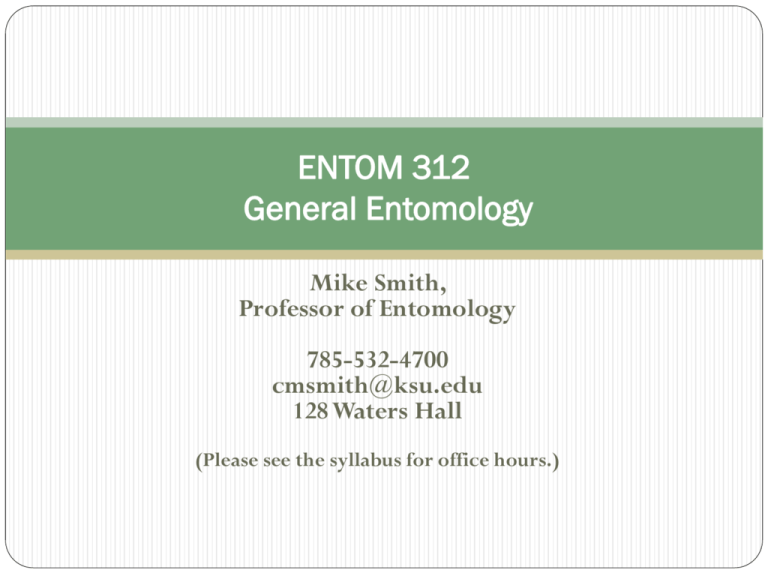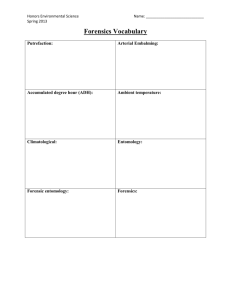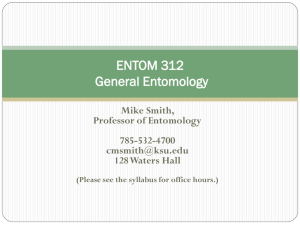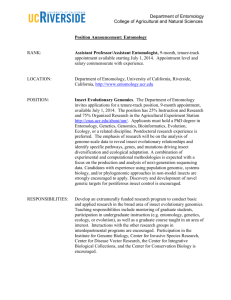ENTOM 312 General Entomology
advertisement

ENTOM 312 General Entomology Mike Smith, Professor of Entomology 785-532-4700 cmsmith@ksu.edu 128 Waters Hall (Please see the syllabus for office hours.) Why Should I Care About Insects ? Course Objectives Students will be able to… Explain the importance of insects Describe basic insect structure and function Describe the basic classification of economically important insects Explain how insects affect humans 2 General Entomology Course Outcomes At the end of the course, you should be able to… Explain which order an insect belongs to Describe something about an insect’s structure and function Increase your insect appreciation and decrease your entomophobia (ento - insect, phobia - fear) Not instinctively want to smash a bug! 3 General Entomology Grading/Assessment Pop Tests (5 @ 10 points each) = 50 points, keep best 4 (40 pts.) In-semester examinations* (3 @ 100 points each) - keep the best 2 scores (200 pts.) Comprehensive final (mandatory) (100 pts.) Group Report Presentations (60 pts.) Grade Composition Pop tests 40 pts. Exams 200 pts. Final 100 pts. Group Reports 60 pts. Total Points 400 pts. Grading Scale: 360 - 400 pts. - A 320 - 359 pts. - B 280 - 319 pts. - C 240 - 279 pts. - D 239 pts. & below - F *Exams (multiple choice, true/false fill-in-the-blank, & short essay questions - based on coherent, complete sentences!). No make-ups, except for true medical emergencies, as explained & verified by physician’s letter. 4 General Entomology What Do You Do to Succeed in the Course ? 1. Come to class. There will always be comments and discussion in class that will not be on the lecture files. 2. Study the class notes before AND after each class. Don’t wait to “react” to what’s presented. You’ll be behind from the start! Read about class lecture & discussion topics ahead of time. Do internet searches of information related to lectures. Read the newspaper. Be ready to ask questions and contribute to each class discussion. 3. DO NOT WAIT UNTIL THE DAY BEFORE AN EXAM TO STUDY !!! 100 years of educational data prove this is a blueprint for failure. Read, re-read, and highlite notes several times before each test. 4. No question is unimportant. Most likely, for every one you think is unimportant, there are several people with the same curiosity. 5. Read “entomocentrically”. Try to see the insect angle in news stories and science news you read. 5 General Entomology Why Study Insects? There are ~ 10 quintillion (10,000,000,000,000,000,000) individual bugs on earth at any given moment !! Insects outnumber humans ~200,000,000 to 1. lbs/acre (U.S.) Insects 400 Humans 14 6 General Entomology Butterflies & Moths 160,000 Ants & Bees - 100,000 Flies - 90,000 Beetles - 350,000 Worms Protoza Mammals- 6,000 Fish Shells Snails Starfish All Other Insects - 100,000 Other Arthropods 1o = 3,000 species ~3/4 of all animals are Insects (~750,000 species) 7 General Entomology Why Classify Organisms? To study anything, we need a system of names - “nomenclature” Similarity is the basis for all nomenclature & morphological traits were the first classifying traits. Carl Linneaus (b. 1707, Sweden), created a system of animal & plant classification called binomial nomenclature: (bi = two; nome = names), i. e. the genus & the species The species is the basic unit of nomenclature; the genus includes several species. ex. Blatella germanica or Blatella germanica 8 General Entomology Taxonomic Category Hierarchy Kingdom - Animalia Phylum Class - Arthropoda Order Family Genus Species Keep Putting Coffee On For Good Students 9 General Entomology Phylum Arthropoda “jointed-feet” 1. Bilateral symmetry 2. An exoskeleton containing chitin 3. Segmented body: 20-21 ring-like metameres 4. Paired, jointed appendages 5. Dorsal heart with open circulation & dorsal brain 6.Ventral nerve cord & tracheal (air) system 10 General Entomology hindgut Malphigian tubules rectum air sacs Dorsal midgut crop heart ostia foregut nerve cord ganglion gonad brain ocellus compound eye spiracles segment Ventral antenna tracheae mouthparts salivary gland tibia tarsus 11 General Entomology femur Arachnida (scorpions, ticks, spiders mites) cephalothorax & abdomen; no antennae; 4 pairs of legs in adults; 1 pair mouthparts (chelicerae) Crustacea (barnacles, crabs, crayfish, lobsters, shrimp, pill bugs) 2 pairs of antennae, 5+ pairs of legs 12 General Entomology Chilopoda (centipedes) wingless, multisegmented trunk, each with 1 pr. legs (except 1st & last 2); 1 pr. antennae; first segment has poison legs (jaws) “toxicognaths” Diplopoda (millipedes) 13 General Jon Entomology Fouskaris wingless; 1 pr. antennae; multi-segmented trunk, each with 2 pr. legs (except 1st 3); segments fused dorsally; many spp. secrete chemical defense that may contain HCN Negative Impacts– The Loss of Life, Food, and Homes • 40% of all world food produced annually is lost to insects • Over 1 million people die each year of malaria, vectored by mosquitoes Early bioterrorism/biowarfare - 1346, Tartar army hurled corpses of victims of fleavectored plague over the walls of Kaffa in southern Russia. 14 General Entomology Positive Impacts - Food, Clothing, Medicine Allantoin, secreted by maggots, discovered to heal Raw silk Silk moth deep wounds in World War I ~1/3 of the human diet is the direct result of insect pollination Silk production in Asia & Europe Scale insects used to make red dyes to color cosmetics, foods, & medicine. Soil fertility from decomposers & burrowers; control of pests by predators and parasites (good bugs) -- ~$20 BILLION per yr. (+) to U.S. economy Egg mass • Insects invading corpses are standard forensic tools used to make accurate estimates of the time and cause of death! 15 General Entomology Summary More insects than ALL other animals 16 combined Crops: the good and the bad Vectors of many diseases BUT provide useful products Crime solving ability Model organisms for research Without insects, life as we know it would not be possible. General Entomology Many insect are so light that gravity has no effect on them. They run up vertical surfaces & if they lose their grip & fall, they are rarely injured when they hit the ground. “Bugs are not going to inherit the earth. They own it now. So we might as well make peace with the landlord” Thomas Eisner 17 General Entomology Conclusion © Some of the imagery has been provided through Wiley- Blackwell™ with their permission. All course contents are copyrighted and should not be used for non-course-learning purposes. 18 General Entomology



